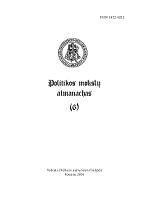SEMCO organizacijos analizė ir rekomendacijos pritaikymui Lietuvos rinkoje
SEMCO CASE ANALYSIS AND RECOMMENDATIONS FOR THE LITHUANIAN MARKET
Author(s): Jonas Kvedaravičius, Darius RažauskasSubject(s): Economy
Published by: Vytauto Didžiojo Universitetas
Keywords: SEMCO; projektas; organizacija; kontrolė; vadyba; SEMCO; project; organization; control; management
Summary/Abstract: Most of today's organizations are in the state of crisis and shocks or even bankruptcies. To understand and explain all the reasons for this is difficult. It seems that common causes lies in the lack of social-cultural systems’ flexibility, weak search for new solutions, creative stagnation, outdated management models, greed and fear of losing control. Analysing global practice and with the aim to find models that had existed in significant change or crisis cannot leave unnoticed Richard Semler and SEMCO case. The analysis of theis company was chosen on purpose. The company's secret of success is not a unique product, a new patent or a monopoly position in the market. SEMCO as a socio-cultural system has a unique organizational model of the project, guided not according to classical management and values. The paper seeks to analyze the company's activities in the external environment, marketing, production organization, management, finance, the company's organizational culture, and its formation of assumptions, the achieved results, and to provide a guidance organizational design model for the Lithuanian market. We believe that this model will be relevant and interesting for Lithuanian business and academic environment. SEMCO organizational design is original and most non-standard compared to other companies. The company produces multi-purpose products of different features, dimensions, and prices and their range is very wide. Therefore, a question naturally arises as to why this company is working successfully, why there is no lack of employment ever, why strikes are so rare and it goes easy through all economic crises, why staff turnover is very low and competitions to vacancies are enormous. The external environment is not the answer, as SEMCO is working in different countries (USA, Brazil, Europe), where geopolitical, legal, infrastructure, competition, risk, economic environment and the situation is different. The differences become apparent when we analyze SEMCO management, employees' work environment, organizational hierarchy, culture, financial management, approach of the owners to their company and other internal issues related to the organization's management, organization, control, and direction. The system was developed as an alternative to the traditional organizational pyramid, which is based on a strict system of subordination. SEMCO company does not deal with a traditional pyramid model of rigidity, a number of hierarchical levels and the presence of a huge bureaucracy. It may seem that such a model is not flexible and slow. However, workers rarely block the advisory decisions, because before taking these decisions are always discussed with the employees. Such a way of decision taking gradually creates friendly, creative and free of any atmosphere in the organization that unbinds employee’s creativity and creates a better work atmosphere. Implementation of SEMCO model does not require higher costs or specific knowledge other than
Journal: Organizacijų vadyba: sisteminiai tyrimai
- Issue Year: 2010
- Issue No: 53
- Page Range: 51-62
- Page Count: 12
- Language: Lithuanian

